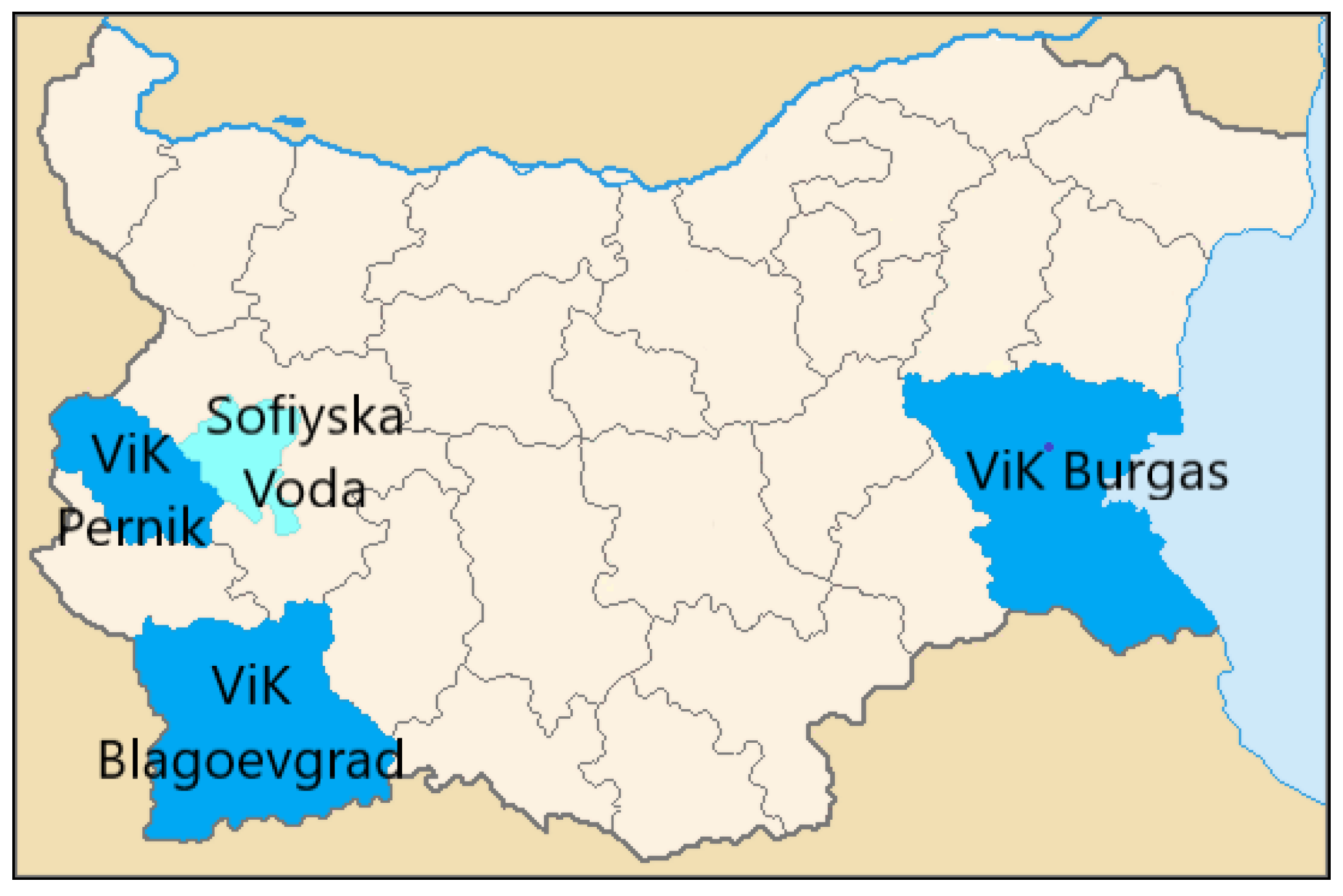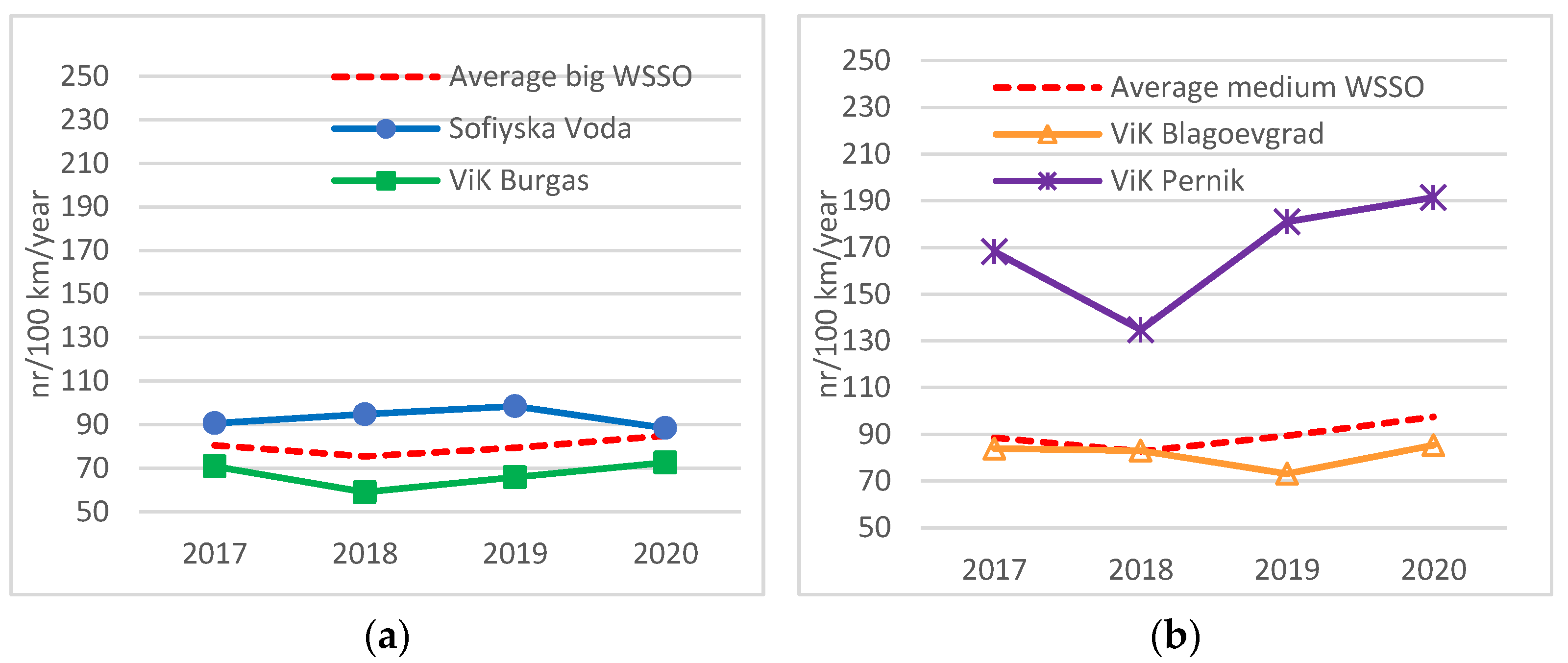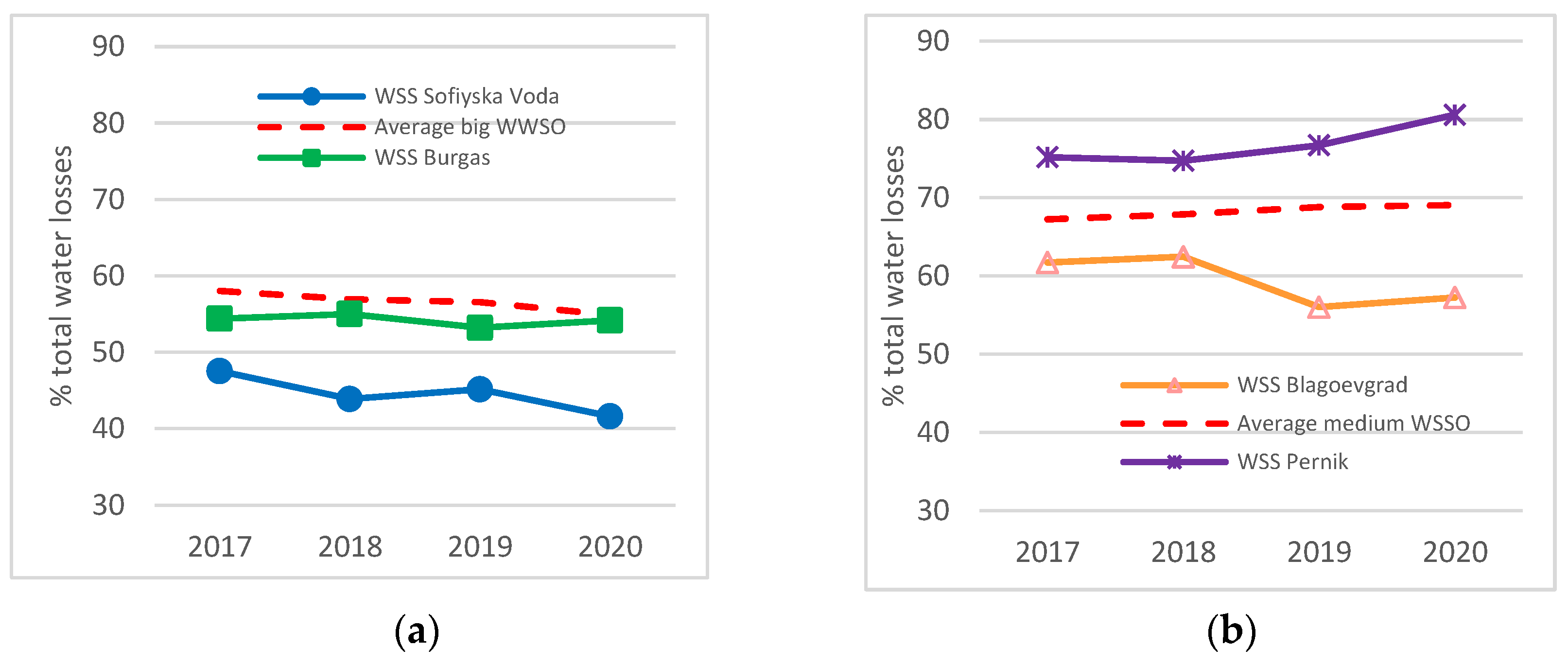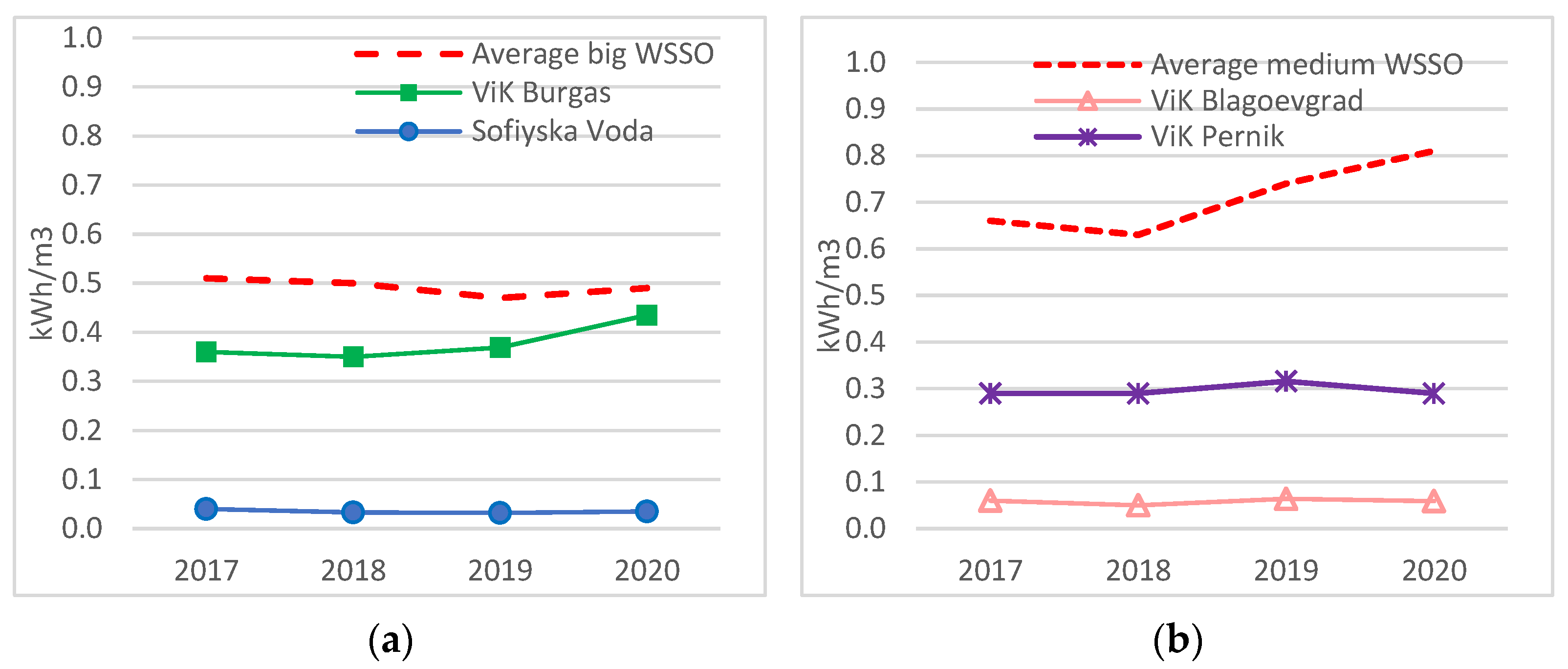The Readiness of the Water Utilities in Bulgaria for Transition toward a Circular Economy
Abstract
:1. Introduction
- ▪
- The water pathway—upstream investments (e.g., solutions for the protection of water at the source resulting in fewer expenses for further treatment), rainwater harvesting, graywater recycling or reuse of (waste)water in agriculture and industry, utilization of reused water for potable needs, prevention of water leakages, and reduction in water consumption.
- ▪
- The materials pathway—increasing the resource efficiency within the treatment processes, sludge utilization for the production of goods (e.g., bioplastics and fertilizers), as input materials for other industries (e.g., paper production and building materials), or for the extraction of metals and minerals and extraction of gases (e.g., carbon dioxide, nitrogen ammonia, and methane) from wastewater effluent.
- ▪
- The energy pathway—increasing the energy efficiency of water supply and sewer systems, energy reduction and recovery of water within households, a yield of electricity from distribution systems, heat yield from sewer networks, utilization of sludge for energy production, and production of renewable energy (e.g., hydropower plants and solar panels).
2. Materials and Methods
- The population covered by the water supply and wastewater service.
- The complexity of water supply and sewer systems—the type of the water sources, characteristics of the water supply and sewer networks, existing drinking water treatment plants (DWTPs) and urban wastewater treatment plants (UWWTPs), and sludge management approaches.
- The form of ownership of the operator, e.g., state, municipal, or private ownership.
3. Results
3.1. Step 1: Selection of Representative WSSOs
- 10 big WSSOs serving about 59% of the population.
- 18 medium WSSOs serving about 35% of the population.
- 10 small WSSOs serving about 5% of the population.
- seven micro WSSOs serving about 1% of the population.
- two big WSSOs—ViK Burgas and Sofiyska Voda.
- two medium WSSOs—ViK Blagoevgrad and ViK Pernik.
- ViK Burgas—the water supply infrastructure is one of the longest in the country, also providing water to the neighboring Varna District. The serviced area is with intensive tourist activities in the summer, as the number of tourists exceeds several times the number of residents.
- Sofiyska Voda services Sofia capital—the most developed region in Bulgaria, with the highest concentration of both population and economic activities. Sofiyska Voda is a part of the international Veolia Group.
- ViK Blagoevgrad services mountainous area with many river intakes with significant seasonal variations of water quality and flow. A substantial part of the population lives in small villages with a lower living standard compared to the urbanized areas.
- The ViK Pernik serviced area neighbors that of Sofiyska Voda. It, however, has a lower rate of social and economic development. In 2019–2020, Pernik suffered from severe water shortage due to insufficient water volume in the main water source—Studena Dam.
3.2. Step 2: Analysis of the Internal Environment (Strengths and Weaknesses) of the Selected WSSOs for Applying Circular Economy
3.2.1. Condition of the Water Supply and Sewerage Infrastructure
3.2.2. Approaches Related to Circular Economy along the Water Pathway
- Upstream measures for the protection of water sources
- Control and prevention of water leakages
3.2.3. Approaches Related to Circular Economy along the Energy Pathway
- Water power utilization for energy production
- Overall energy efficiency of the water supply and sewerage networks
3.2.4. Approaches Related to Circular Economy along the Materials Pathway
3.2.5. Communication and Cooperation with Other Stakeholders or Research Institutions
3.2.6. Identified Strengths and Weaknesses
- The WSSOs have already implemented circular solutions, although they are mostly conventional, targeting efficiency of water use through the decrease in NRW, green energy yield (HPPs, biogas), and/or sludge application in agriculture.
- SCADA systems have been implemented and are continuously developed especially for the water supply networks, DWTPs, and WWTPs, thus contributing to the digitalization of the management and operation of the facilities, allowing efficient online control of the processes and detailed database establishment.
- Sufficient data are available and organized in appropriate registers and databases allowing sound evaluation of systems’ performance and drawbacks. The establishment of a GIS register is in progress for most of the WSSOs, which may significantly facilitate the efficiency of water utilization.
- The water supply networks are well developed, covering almost 100% of the population. The sewer systems cover the bigger settlements, although the rate of the connection is lower than the water supply ones. This means that the WSSOs have good management and operational experience, which may facilitate the transition to a circular economy.
- Most of the WSSOs are already beneficiaries of regional projects for modernization of the water supply and sewerage infrastructure (including implementation of circular solutions) co-financed by the EU Cohesion Fund.
- A majority of the water supply and sewerage infrastructure is 50–80 years old and predetermines frequent failures, significant real water losses, and high rates of infiltration/exfiltration in sewer networks. Most of the DWTPs and the older UWWTPs also need modernization. The maintenance/modernization of the existing infrastructure and the implementation of circular solutions demand higher capital costs, which cannot be covered by the budget of the WSSOs alone.
- The NRW and the pressure management of the water supply systems is not satisfactory for most of the WSSOs, thus delaying the decrease in real water losses and the increase in efficiency of water use. The increase in efficiency of water use, without investments for appropriate adaptation of the water supply and sewerage infrastructure, may create operational problems for the systems, resulting in increased costs for maintenance.
- The energy efficiency indicators for water supply and sewerage systems are too general and do not allow a detailed analysis of the energy efficiency performance of the key elements of the water supply and wastewater treatment.
- The implementation of SCADA systems in the sewer networks is not satisfactory. This prevents having a better estimation of the rates of infiltration/exfiltration and a definition of consequent appropriate measures for improvement.
- The “old” design of water supply and sewerage systems makes it more difficult to change the architecture of the networks (especially in the zones with a high concentration of population and activities) following circular economy principles.
- The level of cooperation and exchange of information among the customers and key stakeholders is insufficient. The WSSOs do not actively advertise the benefits of their ready-for-reuse products to the economic sectors that might use them.
- In general, the level of cooperation with scientific and research institutions is not satisfactory and needs to be strengthened (although some WSSOs already benefit from such cooperation).
3.3. Step 3: Analysis of the Macroenvironment for Applying Circular Economy (Opportunities and Threats)
3.3.1. Legislative Background
3.3.2. Environmental Factors
3.3.3. Economic Factors
- Cost of the water supply and sewerage services
- Market for reused water products
3.3.4. Social Factors
3.3.5. Identified Opportunities and Threats
- The EU policy and national legislation encourage circular economy development. The developed national strategy for a circular economy encourages wastewater reuse and sludge utilization as a source of energy and nutrients.
- There are eco-efficient products and smart technologies on the EU market that may be installed/implemented for increasing the efficiency of water supply and sewerage systems.
- The EU Cohesion Fund provides opportunities for co-financing the Bulgarian WSSOs for bringing water supply and sewerage systems in line with the requirements of the relevant EU Directives and for improving the efficiency of water and energy use.
- More tangible climate changes may require urgent investments for mitigation of water shortage and/or water reuse. Thus, climate changes may act as a booster for implementing circular economy technologies.
- There is potential for cooperation with research organizations at national and international levels for the development and implementation of innovative technologies.
- The nationally regulated long-term values for some indicators concerning the efficiency of water and energy use are common for all the WSSOs, and this may discourage some of them from investing in further improvements after reaching the long-term target. Tailor-made target values would be more suitable.
- The market of reused products in Bulgaria is at the initial stage of development. The key stakeholders and the public seem not to be aware of the potential of water utilities to be also a producer of valuable ready-to-reuse products.
- Some of the circular economy approaches may require significant investments that may increase the price of water services and provoke a negative reaction from customers.
- The stable tendency of decrease in the population in Bulgaria may decrease the users of water services, and this may reflect negatively on the incomes of the WSSOs for recovery of water services.
3.4. Step 4. Verification of the Results by the Water Utilities
4. Discussion
4.1. In Regard to Identification of Strengths and Weaknesses of the Systems
4.2. In Regard to Identification of Opportunities and Threats
5. Conclusions
Author Contributions
Funding
Data Availability Statement
Acknowledgments
Conflicts of Interest
References
- European Commission. Closing the Loop—An EU Action Plan for the Circular Economy. Communication from the Commission to the European Parliament, the Council, the European Economic and Social Committee and the Committee of the Regions. COM 614 Final. 2015. Available online: https://eur-lex.europa.eu/resource.html?uri=cellar:8a8ef5e8-99a0-11e5-b3b7-01aa75ed71a1.0012.02/DOC_1&format=PDF (accessed on 20 October 2016).
- European Commission. A New Circular Economy Action Plan for a Cleaner and More Competitive Europe. Communication from the Commission to the European Parliament, the Council, the European Economic and Social Committee and the Committee of the Regions. COM 98 Final. 2020. Available online: https://eur-lex.europa.eu/resource.html?uri=cellar:9903b325-6388-11ea-b735-01aa75ed71a1.0017.02/DOC_1&format=PDF (accessed on 15 September 2020).
- European Commission. The European Green Deal. Communication from the Commission to the European Parliament, the Council, the European Economic and Social Committee and the Committee of the Regions. COM 640 Final. 2020. Available online: https://eur-lex.europa.eu/legal-content/EN/TXT/?uri=COM:2020:98:FIN&WT.mc_id=Twitter (accessed on 1 April 2022).
- European Commission. On a Monitoring Framework for the Circular Economy. Communication from the Commission to the European Parliament, the Council, the European Economic and Social Committee and the Committee of the Regions. COM 29 Final. 2018. Available online: https://eur-lex.europa.eu/legal-content/EN/TXT/PDF/?uri=CELEX:52018DC0029&from=EN (accessed on 1 April 2022).
- Eurostat Statistics Explained. Circular Economy—Material Flows. 2021. Available online: https://ec.europa.eu/eurostat/statistics-explained/index.php?title=Circular_economy_-material_flows#Circularity_rate (accessed on 1 April 2022).
- Circle Economy. The Circularity Gap Report 2020: When Circularity Goes from Bad to Worse. The Power of Countries to Change the Game. 2020. p. 13. Available online: https://www.circle-economy.com/resources/circularity-gap-report-2020 (accessed on 20 November 2021).
- Veolia. Water at the Heart of the Circular Economy. 2014. Available online: https://www.veolia.com/sites/g/files/dvc4206/files/document/2014/12/economy-circular-water.pdf (accessed on 27 May 2022).
- Water and Circular Economy: A Whitepaper. 2018. Available online: https://www.acrplus.org/en/epr/water-and-circular-economy-white-paper (accessed on 27 May 2022).
- International Water Association. Water Utility Pathways in a Circular Economy. 2016. Available online: https://iwa-network.org/water-utility-pathways-circular-economy-charting-course-sustainability (accessed on 10 July 2018).
- Israeli Water System. R2Pi—The Route to Circular Economy. A Circular Economy Business Model Case. 2019. Available online: https://minerva.usc.es/xmlui/bitstream/handle/10347/20417/R2Pi_Case%20Study%20Report_Israel%20Water_FINAL%20%282%29.pdf?sequence=1&isAllowed=n (accessed on 20 April 2022).
- Mbavarira, T.M.; Grimm, C. A Systemic View on Circular Economy in the Water Industry: Learnings from a Belgian and Dutch Case. Sustainability 2021, 13, 3313. [Google Scholar] [CrossRef]
- Mannina, G.; Badalucco, L.; Barbara, L.; Cosenza, A.; Di Trapani, D.; Gallo, G.; Laudicina, V.A.; Marino, G.; Muscarella, S.M.; Presti, D.; et al. Enhancing a Transition to a Circular Economy in the Water Sector: The EU Project WIDER UPTAKE. Water 2021, 13, 946. [Google Scholar] [CrossRef]
- Mainali, B.; Ngo, H.H.; Guo, W.S.; Pham, T.T.N.; Wang, X.C.; Johnston, A. SWOT analysis to assist identification of the critical factors for the successful implementation of water reuse schemes. Desalin. Water Treat. 2011, 32, 297–306. [Google Scholar] [CrossRef]
- Srdjevic, Z.; Bajcetic, R.; Srdjevic, B. Identifying the Criteria Set for Multicriteria Decision Making Based on SWOT/PESTLE Analysis: A Case Study of Reconstructing a Water Intake Structure. Water Resour. Manag. 2012, 26, 3379–3393. [Google Scholar] [CrossRef]
- Gao, X.; Chen, L.; Sun, B.; Liu, Y. Employing SWOT Analysis and Normal Cloud Model for Water Resource Sustainable Utilization Assessment and Strategy Development. Sustainability 2017, 9, 1439. [Google Scholar] [CrossRef] [Green Version]
- Nagara, G.; Lam, W.-H.; Lee, N.C.H.; Othman, F.; Shaaban, G. Comparative SWOT Analysis for Water Solutions in Asia and Africa. Water Resour. Manag. 2015, 29, 125–138. [Google Scholar] [CrossRef] [Green Version]
- Energy and Water Regulatory Comission of Bulgaria. Annual Report and Comparative Analysis of the Condition of the Water Supply and Sewarage Sector in the Republic of Bulgaria for 2020. 2021. Available online: https://www.dker.bg/uploads/documents/vik/prot_215_21.pdf (accessed on 10 November 2021).
- Business Plan for the Development of “Vodosnabdyavane I Kanalizacia” EOOD Blagoevgrad for the Period 2017–2021. Available online: http://vikblg.com/wp-content/uploads/2019/01/bp-2017-2021za-KEVR_final_petrich_2020.pdf (accessed on 9 March 2020).
- Business Plan for the Development of “Vodosnabdyavane I Kanalizacia” EAD Burgas for the Period 2017–2021. Available online: https://vik-burgas.com/page/83-Biznes-plan-2017 (accessed on 9 March 2020).
- Business Plan for the Development of “Vodosnabdyavane I Kanalizacia” OOD Pernik for the Period 2017–2021. Available online: https://www.vik-pernik.eu/documents/biznesplan2017vikPk.pdf (accessed on 9 March 2020).
- Business Plan for the Devlopment of “Sofiyska Voda” AD for the Period 2017–2021. Available online: https://www.sofiyskavoda.bg/dokumenti/biznes-plan (accessed on 9 March 2020).
- Energy and Water Regulatory Comission of Bulgaria. Annual Report and Comparative Analysis of the Condition of the Water Supply and Sewarage Sector in the Republic of Bulgaria for 2017. 2018. Available online: https://www.dker.bg/uploads/documents/vik/sravnitelen-analiz-vik-2017.pdf/ (accessed on 10 November 2021).
- Energy and Water Regulatory Comission of Bulgaria. Annual Report and Comparative Analysis of the Condition of the Water Supply and Sewarage Sector in the Republic of Bulgaria for 2018. 2019. Available online: https://www.dker.bg/uploads/documents/vik/sravnitelen-analiz-vik-2018.pdf (accessed on 10 November 2021).
- Energy and Water Regulatory Comission of Bulgaria. Annual Report and Comparative Analysis of the Condition of the Water Supply and Sewarage Sector in the Republic of Bulgaria for 2019. 2020. Available online: https://www.dker.bg/uploads/documents/vik/prot_257_20.pdf (accessed on 10 November 2021).
- Liemberger, R.; Farley, M. Developing a Nonrevenue Water Reduction Strategy Part 1: Investigating and Assessing Waterlosses. Available online: https://www.researchgate.net/publication/228707498_Developing_a_Non-Revenue_Water_Reduction_Strategy_Part_1_Investigating_and_Assessing_Water_Losses (accessed on 20 April 2022).
- The European Federation of National Water Associations; EurEau. Europe’s Water in Figures. An Overview of the European Drinking Water and Waste Water Sectors. 2021; pp. 20–33. Available online: https://www.eureau.org/resources/publications/eureau-publications/5824-europe-s-water-in-figures-2021/file (accessed on 10 April 2022).
- Kalinkov, P.; Vladov, G.; Radovanov, V. Studies and procedures of water loss reduction in the water supply system of the town of Vidin. Water Util. J. 2011, 1, 11. [Google Scholar]
- WWF—Rivers of Bulgaria. Public Register of Installations for Production of Electricity from Renewable Energy Sources (RES). 2021. Available online: https://www.veiregistar.bg (accessed on 10 November 2021).
- WWF—Rivers of Bulgaria. List of Water Power Stations in Operation in Bulgaria. 2021. Available online: https://dams.reki.bg/Dams/List (accessed on 10 November 2021).
- Ribarova, I.; Dimitrova, S.; Lambeva, R.; Wintgens, T.; Stemann, J.; Remmen, K. Phosphorus recovery potential in Sofia WWTP in view of the national sludge management strategy. Resour. Conserv. Recycl. 2017, 116, 152–159. [Google Scholar] [CrossRef]
- Dinova, N.; Belouhova, M.; Schneider, I.; Rangelov, Z.; Topalova, Y. FISH analysis of microbial communities in a full-scale technology for biogas production. Eng. Life Sci. 2018, 18, 914–923. [Google Scholar] [CrossRef] [Green Version]
- Valchev, D.; Ribarova, I.; Uzunov, B.; Stoyneva-Gärtner, M. Photo-sequencing batch reactor with Klebsormidium nitens: A promising microalgal biotechnology for sustainable phosphorus management in wastewater treatment plants. Water Sci. Technol. 2021, 83, 2463–2476. [Google Scholar] [CrossRef]
- Valchev, D.; Ribarova, I. A Review on the Reliability and the Readiness Level of Microalgae-Based Nutrient Recovery Technologies for Secondary Treated Effluent in Municipal Wastewater Treatment Plants. Processes 2022, 10, 399. [Google Scholar] [CrossRef]
- Peeva, G.; Koleva, R.; Stancheva, M.; Yemendzhiev, H.; Nenov, V. Phosphorus Recovery from Waste as Struvite. Ecol. Eng. Environ. Prot. 2020, 2, 34–44. Available online: http://ecoleng.org/archive/2020/2/34-44.pdf (accessed on 5 April 2022). [CrossRef]
- Peeva, G.; Yemendzhiev, H.; Nenov, V. Precipitation of struvite from digested sewage sludge by sea water brine and natural flocculants. J. Chem. Technol. Metall. 2022, 57, 310–318. [Google Scholar]
- European Environmental Agency. Guidelines on Integrating Water Reuse into Water Planning and Management in the Context of the WFD. 2016. Available online: https://www.eea.europa.eu/policy-documents/guidelines-on-integrating-water-reuse (accessed on 15 December 2021).
- European Commission. Regulation (EU) 2020/741 of the European Parliament and of the Council of 25 May 2020 on Minimum Requirements for Water Reuse. Off. J. Eur. Union 2020, 177, 32–55. Available online: https://eur-lex.europa.eu/legal-content/EN/TXT/?uri=CELEX%3A32020R0741 (accessed on 15 December 2021).
- European Commission. Commision Regulation (EU) No 547/2012 of 25 June 2012 Implementing Directive 2009/125/EC of the European Parliament and of the Council with Regard to Ecodesign Requirements for Water Pumps. Off. J. Eur. Union 2020, 165, 28. Available online: https://eur-lex.europa.eu/legal-content/EN/TXT/?uri=CELEX%3A32012R0547 (accessed on 15 December 2021).
- Strategy and Action Plan for Transition to the Circular Economy of the Republic of Bulgaria for the Period 2021–2027. Available online: https://www.moew.government.bg/bg/strategiya-i-plan-za-dejstvie-za-prehod-kum-krugova-ikonomika-na-republika-bulgariya-za-perioda-2021-2027-g-10910/ (accessed on 15 December 2021).
- Ordinance for regulation of the quality of water supply and sewerage services. Adopted by CMD № 8 of 18.01.2016. Bulg. State Gaz. 2016, 6. Available online: https://www.lex.bg/bg/laws/ldoc/2136727660 (accessed on 8 June 2022).
- Ministry of Environment and Water Bulgaria. National Climate Change Adaptation Strategy and Action Plan Advisory Services on a National Climate Change Adaptation Strategy and Action Plan. Water Sector Assessment. 2019. Available online: https://www.moew.government.bg/en/climate/international-negotiations-and-adaptation/adaptation/ (accessed on 26 April 2022).
- National Institute on Meteorology and Hydrology. Assessment of the Security of Water Supply of the Town of Pernik and Rules for Management of Studena Dam. 2020. Available online: https://www.moew.government.bg/ (accessed on 26 April 2022).
- Stoyneva-Gärtner, M.P.; Descy, J.-P.; Latli, A.; Uzunov, B.A.; Pavlova, V.T.; Bratanova, Z.; Babica, P.; Maršálek, B.; Meriluoto, J.; Spoof, L. Assessment of cyanoprokaryote blooms and of cyanotoxins in Bulgaria in a 15-years period (2000–2015). Adv. Oceanogr. Limnol. 2017, 8, 131–152. [Google Scholar] [CrossRef] [Green Version]
- Jöhnk, K.D.; Huisman, J.; Sharples, J.; Sommeijer, B.; Visser, P.M.; Stroom, J.M. Summer heatwaves promote blooms of harmful Cyanobacteria. Glob. Chang. Biol. 2008, 14, 495–512. [Google Scholar] [CrossRef] [Green Version]
- Whitehead, P.G.; Wilby, R.L.; Battarbee, R.W.; Kernan, M.; Wade, A.J. A review of the potential impacts of climate change on surface water quality. Hydrol. Sci. J. 2009, 54, 101–123. [Google Scholar] [CrossRef]
- Paerl, H.W.; Paul, V.J. Climate change: Links to global expansion of harmful cyanobacteria. Water Res. 2012, 46, 1349–1363. [Google Scholar] [CrossRef]
- Cardoso, M.A.; Silva, M.S.; Coelho, S.T.; Almeida, M.C.; Covas, D.I. Urban water infrastructure asset management—A structured approach in four water utilities. Water Sci. Technol. 2012, 66, 2702–2711. [Google Scholar] [CrossRef] [PubMed]
- Mirshafiei, P.; Sadeghi-Niaraki, A.; Shakeri, M.; Choi, S.-M. Geospatial Information System-Based Modeling Approach for Leakage Management in Urban Water Distribution Networks. Water 2019, 11, 1736. [Google Scholar] [CrossRef] [Green Version]
- Kingdom, B.; Liemberger, R.; Marin, P. The Challenge of Reducing Non-Revenue Water (NRW) in Developing Countries. How the Private Sector Can Help: A Look at Performance-Based Service Contracting. Water Supply and Sanitation Sector Board Discussion Paper Series, Paper No 8, December 2006, p. 3. Available online: https://ppiaf.org/documents/2076/download (accessed on 10 April 2022).
- Feldman, M. Aspects of Energy Efficiency in Water Supply systems. Available online: https://www.miya-water.com/fotos/artigos/01_aspects_of_energy_efficiency_in_water_supply_systems_29087895a3270d5aa1bd_3921316675f181f7967c82.pdf (accessed on 21 April 2022).
- Nazif, S.; Karamouz, M.; Tabesh, M.; Moridi, A. Pressure Management Model for Urban Water Distribution Networks. Water Resour. Manag. 2010, 24, 437–458. [Google Scholar] [CrossRef]
- Ociepa, E.; Mrowiec, M.; Deska, I. Analysis of Water Losses and Assessment of Initiatives Aimed at their Reduction in Selected Water Supply Systems. Water 2019, 11, 1037. [Google Scholar] [CrossRef] [Green Version]
- Kofinas, D.; Ulanczyk, R.; Laspidou, C.S. Simulation of a Water Distribution Network with Key Performance Indicators for Spatio-Temporal Analysis and Operation of Highly Stressed Water Infrastructure. Water 2020, 12, 1149. [Google Scholar] [CrossRef] [Green Version]
- Perrone, D.; Murphy, J.; Hornberger, G.M. Gaining Perspective on theWater-Energy Nexus at the Community Scale. Environ. Sci. Technol. 2011, 45, 4228–4234. [Google Scholar] [CrossRef]







| Parameter | ViK Burgas | Sofiyska Voda | ViK Blagoevgrad | ViK Pernik |
|---|---|---|---|---|
| Number of serviced settlements (towns), n | 249 (20) | 38 (4) | 147 (10) | 117 (6) |
| Serviced population, n | 415,000 | 1,319,804 | 277,240 | 125,000 |
| Urban population, % | 76 | 95.5 | 60 | 78 |
| Connection to WSN, % | 99.9 | 100 | 99 | 98 |
| Major water sources | Kamchia Dam, Yasna Polyana Dam | Iskar Dam, Beli Iskar Dam | River intakes, springs | Studena Dam, Krasava Dam, Baniste Dam |
| Existing DWTPs, n | 2 | 4 | 4 | 3 |
| WSN predominant type | Gravitational and pumping | Gravitational | Gravitational | Gravitational and pumping |
| Connection to SN, % | 76 | 96 | 85 | 73 |
| Existing UWWTPs, n | 18 | 1 | 17 | 1 |
| Connection to UWWTPs, % | 64 | 91 | 52 | 68 |
| SN predominant type (combined, separate mixed); pumping or gravitational | Combined, gravitational and pumping | Combined gravitational and pumping, | Combined, gravitational and pumping | Combined, gravitational |
| WSSO ownership | 100% state | 77.1% private 22.9% municipal | 100% state | 51% state 49% municipal |
| Operator | 2017 | 2018 | 2019 | 2020 |
|---|---|---|---|---|
| ViK Burgas | 0 | 0 | 0.28 | 2.39 |
| Sofiyska Voda | 0 | 0 | 0 | 0 |
| ViK Blagoevgrad | 0 | 0.47 | 3.77 | 3.91 |
| ViK Pernik | 0 | 0 | 84.45 | 83.34 |
| Average for Bulgaria | 2.99 | 1.07 | 5.95 | 3.92 |
| ViK Burgas | ViK Blagoevgrad | ViK Pernik | Sofiyska Voda | |
|---|---|---|---|---|
| Complex price | 1.58 | 1.20 | 1.24 | 1.41 |
| Socially affordable price | 2.24 | 2.06 | 2.36 | 4.27 |
| ViK Burgas | ViK Blagoevgrad | ViK Pernik | Sofiyska Voda |
|---|---|---|---|
| 2.7% decrease | 7.6% decrease | 10.6% decrease | 3.9% increase |
Publisher’s Note: MDPI stays neutral with regard to jurisdictional claims in published maps and institutional affiliations. |
© 2022 by the authors. Licensee MDPI, Basel, Switzerland. This article is an open access article distributed under the terms and conditions of the Creative Commons Attribution (CC BY) license (https://creativecommons.org/licenses/by/4.0/).
Share and Cite
Dimova, G.; Dimitrova, S.; Kostova, I.; Lazarova, S.; Ribarova, I.; Stoyanov, D.; Tonev, R.; Tsanov, E.; Valchev, D. The Readiness of the Water Utilities in Bulgaria for Transition toward a Circular Economy. Processes 2022, 10, 1156. https://doi.org/10.3390/pr10061156
Dimova G, Dimitrova S, Kostova I, Lazarova S, Ribarova I, Stoyanov D, Tonev R, Tsanov E, Valchev D. The Readiness of the Water Utilities in Bulgaria for Transition toward a Circular Economy. Processes. 2022; 10(6):1156. https://doi.org/10.3390/pr10061156
Chicago/Turabian StyleDimova, Galina, Sonya Dimitrova, Irina Kostova, Svetlana Lazarova, Irina Ribarova, Dean Stoyanov, Radoslav Tonev, Emil Tsanov, and Dobril Valchev. 2022. "The Readiness of the Water Utilities in Bulgaria for Transition toward a Circular Economy" Processes 10, no. 6: 1156. https://doi.org/10.3390/pr10061156
APA StyleDimova, G., Dimitrova, S., Kostova, I., Lazarova, S., Ribarova, I., Stoyanov, D., Tonev, R., Tsanov, E., & Valchev, D. (2022). The Readiness of the Water Utilities in Bulgaria for Transition toward a Circular Economy. Processes, 10(6), 1156. https://doi.org/10.3390/pr10061156






